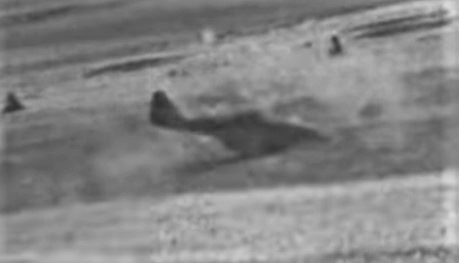Go  | New  | Find  | Notify  | Tools  | Reply  |  |
| Freethinker |
A screen shot from a YouTube gun camera video (at 6:03) of a downed German aircraft being strafed on the ground by an American plane. My impression is that it was an Me 262, but I’m no authority. Possibly something else? Comments?  LINK ► 6.0/94.0 I can tell at sight a Chassepot rifle from a javelin. | ||
|
Member |
Looks like an Me262 to me | |||
|
| Crusty old curmudgeon |
The tail is distinctive to the Me262. Jim ________________________ "If you can't be a good example, then you'll have to be a horrible warning" -Catherine Aird | |||
|
| Happiness is Vectored Thrust |
Yes. Definitely a ME262 Icarus flew too close to the sun, but at least he flew. | |||
|
| Member |
Nice aerial combat footage and strafing runs in the provided link. Does anyone know at what distance the wing mounted machine guns were calibrated to converge? __________ "I'd rather have a bottle in front of me than a frontal lobotomy." | |||
|
Official Space Nerd |
Me-262. They had very weak nose gear legs, so a landing on a plowed field would snap that nose gear like dry spaghetti. . . They were wicked fast (a good 100 mph faster than most allied fighters), but had lousy accelleration and slow throttle response. Therefore, they had long, slow landing approaches. The Germans put extra AA guns on the approaches to their runways to protect the -262s, and even had extra prop fighters assigned to protect them. Still, takeoffs and landings were very dangerous for the early jets. Allied fighters got most of the -262 kills when they were trying to land. Fear God and Dread Nought Admiral of the Fleet Sir Jacky Fisher | |||
|
| I run trains! |
Depends, some pilots preferred to have them converge at a set distance while some preferred a spread without converging. I’ve never seen anything to suggest that the Army Airforce had a standard on how these guns were setup from aircraft to aircraft. Success always occurs in private, and failure in full view. Complacency sucks… | |||
|
| Casuistic Thinker and Daoist |
Yup, Me-262 No, Daoism isn't a religion | |||
|
| Coin Sniper |
It was a Me-262. Now it is a collection of spare parts and twisted sheet metal. Pronoun: His Royal Highness and benevolent Majesty of all he surveys 343 - Never Forget Its better to be Pavlov's dog than Schrodinger's cat There are three types of mistakes; Those you learn from, those you suffer from, and those you don't survive. | |||
|
| Slayer of Agapanthus |
If you like WWII aircraft stuff please look up the YT channel 'Greg's Planes and Automobiles'. "It is only with the heart that one can see rightly; what is essential is invisible to the eye". The Little Prince, Antoine de Saint-Exupery, pilot and author, lost on mission, July 1944, Med Theatre. | |||
|
Official Space Nerd |
As stated, it varied. Some units standardized at 200 yards, IIRC. Many aces advocated getting so close you couldn't miss (like 50-100 yards). Some removed the tracer bullets so as to not give their target a warning. . . Fear God and Dread Nought Admiral of the Fleet Sir Jacky Fisher | |||
|
| Freethinker |
Before this fades into oblivion, thanks to those who helped confirm my impression about the aircraft. | |||
|
Baroque Bloke |
For a really unusual aircraft check out the WW II German Blohm & Voss BV 141: https://en.m.wikipedia.org/wiki/Blohm_%26_Voss_BV_141 Serious about crackers. | |||
|
| Imagination and focus become reality |
I've heard that the ME-262 was the first aircraft to break the sound barrier. Obviously, that is difficult to prove. | |||
|
Fighting the good fight |
"Hans Guido Mutke claimed to have broken the sound barrier on 9 April 1945 in the Messerschmitt Me 262 jet aircraft. He states that his Air Speed Indicator pegged itself at 1,100 kilometres per hour (680 mph). Mutke reported not just transonic buffeting, but the resumption of normal control once a certain speed was exceeded, then a resumption of severe buffeting once the Me 262 slowed again. He also reported engine flame-out. This claim is widely disputed, even by pilots in his unit. All of the effects he reported are known to occur on the Me 262 at much lower speeds, and the ASI reading is simply not reliable in the transonic. Further, a series of tests made by Karl Doetsch at the behest of Willy Messerschmitt found that the plane became uncontrollable above Mach 0.86, and at Mach 0.9 would nose over into a dive that could not be recovered from. Post-war tests by the RAF confirmed these results, with the slight modification that the maximum speed using new instruments was found to be Mach 0.84, rather than Mach 0.86." | |||
|
| Member |
Check out this site for unusual German aircraft. Luft 46 From what I understand the ME262 needed cover during landings when they were most vulnerable. Many great German aces flew them. Let all Men know thee, but no man know thee thoroughly: Men freely ford that see the shallows. Benjamin Franklin | |||
|
| Powered by Social Strata |
| Please Wait. Your request is being processed... |
|
© SIGforum 2025